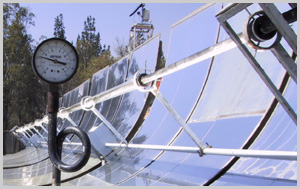
![]()
Mechanics and Energy
 __________________________________________________________________________________
__________________________________________________________________________________
In 1968, Alberto Camacho initiated some theoretical and applied research in the area of mechanical design and, in 1970, formally began this department, but with the name of "Mechanics, Thermal and Fluids", taking its current name in October 2007.
Research in this department include the design of mechanical devices, with emphasis on transportation and load-carrying, like a tractor and an electric car, products and devices to harness solar energy and biomass such as selective surfaces, mirrors, sunscreens, concentrators, solar water heaters, solar ponds, anaerobic digesters and solar thermal power generation, mechanical properties of materials, theoretical models and measurement instrumentation for the flow and management of large volumes of water such as channels and aqueducts, and recently added an area for sustainable housing and bioclimatic design.
There have been numerous publications in journals, books and conferences as well as talks and lectures at various venues, radio and television to disseminate research results. There are also two patents.
The department is comprised of ten investigators; nine with doctoral degrees, three with masters and ten belong to the National Researchers System (SNI). There are also six technicians, four with master's degree and one with a bachelor's degree. It also adds support staff such as laboratory technicians, mechanic shop employees and secretaries. A large number of undergraduate, graduate and doctoral research assistants have helped and their contribution has been acknowledged in various publications. Currently there are 12 undergraduate, 15 masters and a doctoral student. A postdoc fellow is also part of the department. The department carries out its activities in building 12, 2nd floor and mechanic shop, Engineering Tower, 2nd floor, and the laboratories in building 18, as well as the solar plant.